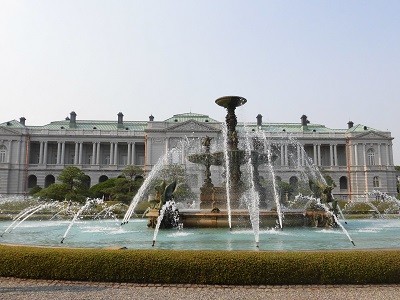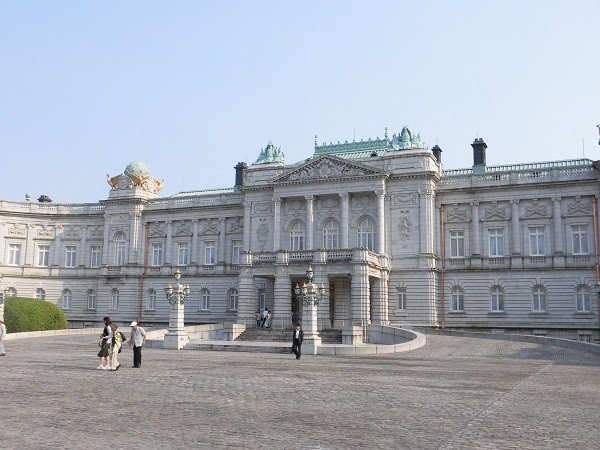The Geihinkan in Tokyo is also known as the Akasaka Palace or the State Guest House. It is a very beautiful building with a gorgeous classic interior and a French garden with a Japanese Pavillion. Geihinkan is a relatively unknown architectural and cultural gem where you can see a splendid mixture of Western and Japanese influences. If you want to see one of Tokyo’s treasures without the international tourist crowd, Geihinkan should be on your to-see list!
History of Geihinkan
Geihinkan was constructed in 1909. It was originally built for then crown prince Yoshihito by his father Emperor Meiji as his residence. But he did not live there. It is said that he found it too luxurious to live in when most of the ordinary citizens lived in small houses.
It was sometimes used as a state guest house. In 1922, the British crown prince Edward stayed there. He was the first foreign guest who stayed at the building. After WWII, the Japanese government took ownership and used it in many ways. For example, as a national library, a court of impeachment, and as the office of the Tokyo Olympic Committee for the Olympic Games held in 1964.
There actually already was a state guest house in Tokyo at that time. The site was the former residence of Asaka-no-Miya, one of the Imperial Family members. But it was deemed too small, so the government decided to transform the former crown prince’s building into the new state guest house. After a 5-year construction period, it was finished in 1974.
Since then, it has been used as Japan’s unique state-owned hotel and also for important international meetings. A Tokyo Summit and G-7 meetings were held there three times. After a meeting, they would hold banquets in the building’s luxurious rooms. About 20 people can stay at the same time and about 350 foreign guests have stayed there until now. In 2005, another state guest house was constructed in Kyoto.
Construction of Geihinkan
Geihinkan was designed by the famous architect Katayama Tokuma who was a student of British architect Josiah Conder. Conder was invited by the Japanese government to teach Western construction in the late 19th century. Before designing Geihinkan, he visited Europe and the USA. He referred to Western palace buildings when designing Geihinkan. So the façade of the building looks like the neo-baroque style of Buckingham Palace and Louvre Palace. It was the first western-style palace building designed by the Japanese.
Also, construction material was important because Japan has a lot of earthquakes. It was the first authentic building using steel beams in Japan. They also used granite stone and bricks to make thick walls. The thickest part of the wall is 1.8 meters. So when the Great Kanto Earthquake occurred in 1923, the building did not get any damage. The building has Japan’s first air-conditioning system and electricity was used all over the building.
A Visit to the Geihinkan
You can visit some parts of the Geihinkan when the government is not using it. The beautifully decorated rooms are very impressive.



Kacho-no-Ma
This is the room that is used for banquets. The room can hold about 130 people. Kacho means flowers and birds, or the scenery of nature. The whole room was designed according to the French Henri II style. Dark wood gives the room a calm atmosphere. The 36 ceiling and wall paintings were made by a French painter. 30 round cloisonné panels were made in a collaboration of painter Watanabe Seitei and cloisonné artist Namikawa Sosuke. Namikawa used a special technique without metal dividers. The Gobelin-style tapestry was made in Nishijin, Kyoto.
Sairan-no-Ma
The Sairan-no-Ma was used as a waiting room before the banquet, top-level meeting, or signing ceremony started. A Sairan is a beautiful imaginary sacred bird. The whole room was designed according to the French Empire style or Napoleon I style. It looks really gorgeous because of the usage of gold plates on the plaster. The room looks much wider than it really is because of the 10 huge mirrors. Though the whole design has a western atmosphere, you will find Japanese motifs such as samurai armors, helmets, and swords if you take a closer look.
Asahi-no-Ma
This is the room of the highest status. It is used for top meetings and as a farewell salon to talk with the Emperor. Asahi means the morning sun. Goddess Aurora with the morning sun is painted on the ceiling. They used gold-plated decorations on the plaster, too. The tapestries on the wall were hand-made in Nishijin, Kyoto. The chandeliers in the room are gorgeous.
Dance Room and Garden
Hagoromo-no-Ma
This room is used for top meetings and as a cocktail room before the banquet. It looks like the Mirror Room in Versailles Palace. Hagoromo is the title of an old Japanese song based on mythology, which is expressed on the ceiling. With the orchestra box, this room used to be called a dance room. The decorations on the wall have motifs of the music which includes Japanese musical instruments. The chandeliers in the room are the biggest in the building.
Front Entrance & Large Hall
The front entrance is gorgeous with the check board-designed floor using Italian marble and special Japanese stone. In the large hall, there are eight Corinthian pillars made of Italian marble. There are two oil paintings by Koiso Ryohei titled ‘Music’ and ‘Painting’.
Main Garden
The Main Garden is a symmetrical French-style garden. The big water fountain is decorated with sculptures of turtles, killer whales, and griffons. Seasonal flowers bloom year-round. Three trees were planted by state guests US President Ford in 1974, British Queen Elisabeth in 1975, and former Soviet Union’s President Gorbachev in 1991.

Yushintei
The Yushintei is a Japanese-style pavilion that was added in 2009. State guests can enjoy Japanese cultural experiences such as tea ceremonies and flower arrangements. They can feed koi carp in the pond, too. Japanese meals such as sushi and tempura are served in a small restaurant. You can visit this part only with a guided tour.
Information
Access: Five-minute walk from Yotsuya Station of JR Chuo Line and Tokyo Metro.
Fee: Main building and main garden: 1,500 yen for adults / 1,000 yen for university students / 500 yen for junior and senior high school students / free for elementary school students
Main building, Yushintei and main garden: 2,000 yen for adults / 1,500 yen for university students / 700 yen for junior and senior high school students / elementary school students and younger are not allowed to visit. You need a reservation for Yushintei.
Hours: From 10 am to 5 pm. Closed on Wednesday and when the building is used for state guests.
Your Japan Tour
As seasoned Japan experts, we can help you create your perfect Japan tour including guides who can take you to the Geihinkan. The guide can take you to the venue and explain all the beautiful rooms if you wish. Check out our group tours and private tours, or contact us to start planning your unforgettable holiday to this fascinating country. Japan is full of once-in-a-lifetime experiences, culture, history, nature, and delicious food!

